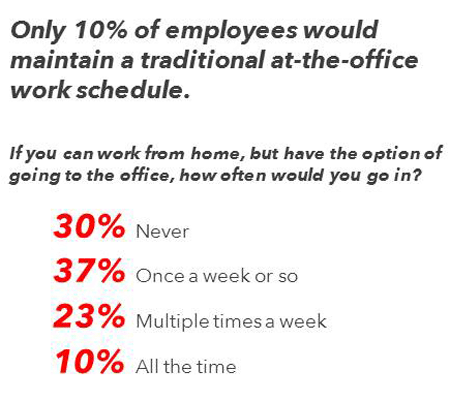Ninety percent of Americans do not want to maintain a traditional work schedule, and almost one-third would never go back to an office, reports new Center study
August 26, 2020 — Almost all Americans want to change their work life when the COVID-19 pandemic ends, with large percentages ready to shift to a permanent home office, according to a study by the USC Center for the Digital Future.
 The study found that working from home during the pandemic has created unique opportunities as well as unprecedented challenges for millions of Americans, including reduced visits to an office, increased working from home, or not going to a traditional office at all.
The study found that working from home during the pandemic has created unique opportunities as well as unprecedented challenges for millions of Americans, including reduced visits to an office, increased working from home, or not going to a traditional office at all.
The study found:
• Many Americans want to change their careers and work from home – More than 40 percent (42 percent) want work from home to be permanent, while 25% disagree.
• More than one-quarter could adapt all of their job to working from home — For many, working from home could be a permanent reality; 26% could adapt all of their job to work from home; 22% most of their work, 17% some, 9% a little, 26% none.
• Work after the pandemic — More than one-third of employees anticipate they will work more from home when the pandemic is over (38% would work more from home, 43% the same, 18% less).
• Few would maintain a traditional at-the-office work schedule — Only 10% would maintain a traditional at-the-office work schedule. If given the option of going to the office, 30% would never go, 37% would go once a week, 23% would go multiple times a week, and only 10% would go all the time.
• What employees miss about the office and enjoy about working from home – The sudden shift to working from home has been a mixed success – more flexibility and no commute, but less interaction and structure.
While working from home, Americans enjoy: no commute (65%), more flexibility (64%), relaxed dress (61%), control of the environment (59%), avoiding work politics (38%), no irritating workmates (36%), and fewer disruptions (34%).
When working from home, Americans miss: being somewhere other than home (63%), socializing/interacting with colleagues or customers (59%), workplace structure (56%), and enjoyable aspects of commuting (39%).
• Problems emerge when working at home – Americans report a range of problems working from home, including distractions from children, pets, phone calls, and neighbors (45%); erosion of the boundary between work and home (31%), an overload of online calls and conferences (18%), and lack of privacy (16%).
• For some, productivity and work hours decline – While 17% of Americans say they are more productive working at home, 23% say they are less effective. And although 15% say they work more hours from home, 42% say they work fewer hours from home.
The Coronavirus Disruption Project
The first round of the Center’s Coronavirus Disruption Study, released April 29, revealed many changes – both positive and negative – in relationships, emotional stability, and behavior since the COVID-19 pandemic and safer-at-home restrictions began. The second round of the study, conducted June 19-26, added new questions about political behavior and compared views about working from home, education, media, entertainment, shopping, and political outlooks.
The findings are based on the results of surveys of 1,000 respondents conducted in English from an online panel, with a margin of error of plus or minus three percentage points.
The Center for the Digital Future: revealing disruption for two decades
For more than 20 years, the Center for the Digital Future at USC Annenberg (digitalcenter.org) has explored the impact of digital technologies on the behavior and views of users and non-users. The center also studies disruption in the lives of Americans and the corporate world.
__________

